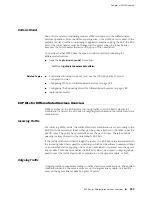
LDP graceful restart if stateful SRP switchover is not configured on the router, the
graceful restart capability will not function.
You can configure an LSR to restart itself gracefully and to support graceful restart
in its neighbors (helper mode), or helper mode alone. In either case, the LSR includes
the fault tolerant (FT) session TLV in the LDP initialization messages it sends at session
startup. The TLV includes values for the reconnect timeout and the recovery time.
When both graceful restart and the helper mode are disabled, the LSR does not
include the TLV in its LDP initialization messages.
The configurable reconnect time specifies how long you want the LSR’s neighbors
to wait for the LSR to resume exchanging LDP messages with the neighbors after
the connection failure. The reconnect timeout value is nonzero when graceful restart
is enabled.
When you disable graceful restart but enable helper mode, the reconnect timeout is
set to zero to announce to the neighbors that the LSR does not preserve MPLS
forwarding state across the restart. The presence of the TLV indicates to the neighbors
that the LSR supports them if they gracefully restart. That is, the LSR in this case
waits for a gracefully restarting neighbor to resume sending messages.
Table 27 on page 248 summarizes the states possible for LDP graceful restart.
Table 27: Summary of LDP Graceful Restart States
Reconnect timeout value
sent in TLV
FT TLV sent to
neighbor?
Helper mode
enabled?
Graceful restart
enabled?
Nonzero
Yes
Yes
Yes
Zero
Yes
Yes
No
–
No
No
No
The recovery time specifies how long the LSR retains its MPLS forwarding state across
the restart. When the LSR restarts, it marks the forwarding state entries as stale. The
forwarding state holding timer begins counting down from the configured recovery
time value. If the timer expires before the restart completes, the LSR deletes all stale
entries. When the LSR sends new LDP initialization messages to its neighbors, the
messages contain the current value of the timer.
When the LSR restarts, if a neighbor of the LSR has previously received the FT session
TLV from the LSR with a nonzero reconnect timeout value, the neighbor retains the
label mapping information that it has previously received from the LSR and marks
that information as stale. Alternatively, if the neighbor received an FT session TLV
with a timeout value of zero (indicating that only helper mode is enabled) or no TLV
at all (indicating that both graceful restart and helper mode are disabled), it deletes
the label mapping information.
Also when the LSR restarts, the neighbor sets its neighbor liveness timer to the lesser
of the two values, the reconnect timeout value and its own configurable neighbor
liveness timer value. If the neighbor liveness timer expires, the neighbor deletes all
248
■
LDP Graceful Restart
JUNOSe 11.1.x BGP and MPLS Configuration Guide
Summary of Contents for BGP
Page 6: ...vi ...
Page 8: ...viii JUNOSe 11 1 x BGP and MPLS Configuration Guide ...
Page 37: ...Part 1 Border Gateway Protocol Configuring BGP Routing on page 3 Border Gateway Protocol 1 ...
Page 38: ...2 Border Gateway Protocol JUNOSe 11 1 x BGP and MPLS Configuration Guide ...
Page 234: ...198 Monitoring BGP JUNOSe 11 1 x BGP and MPLS Configuration Guide ...
Page 236: ...200 Multiprotocol Layer Switching JUNOSe 11 1 x BGP and MPLS Configuration Guide ...
Page 542: ...506 Monitoring BGP MPLS VPNs JUNOSe 11 1 x BGP and MPLS Configuration Guide ...
Page 544: ...508 Layer 2 Services Over MPLS JUNOSe 11 1 x BGP and MPLS Configuration Guide ...
Page 610: ...574 Virtual Private LAN Service JUNOSe 11 1 x BGP and MPLS Configuration Guide ...
Page 624: ...588 VPLS References JUNOSe 11 1 x BGP and MPLS Configuration Guide ...
Page 680: ...644 Virtual Private Wire Service JUNOSe 11 1 x BGP and MPLS Configuration Guide ...
Page 724: ...688 Monitoring MPLS Forwarding Table for VPWS JUNOSe 11 1 x BGP and MPLS Configuration Guide ...
Page 725: ...Part 6 Index Index on page 691 Index 689 ...
Page 726: ...690 Index JUNOSe 11 1 x BGP and MPLS Configuration Guide ...
















































